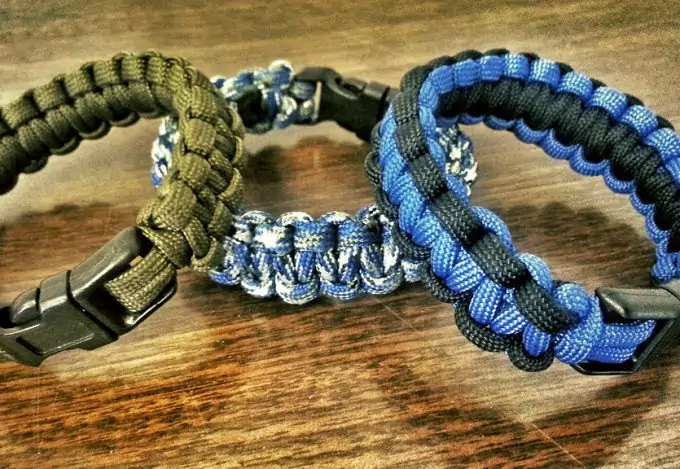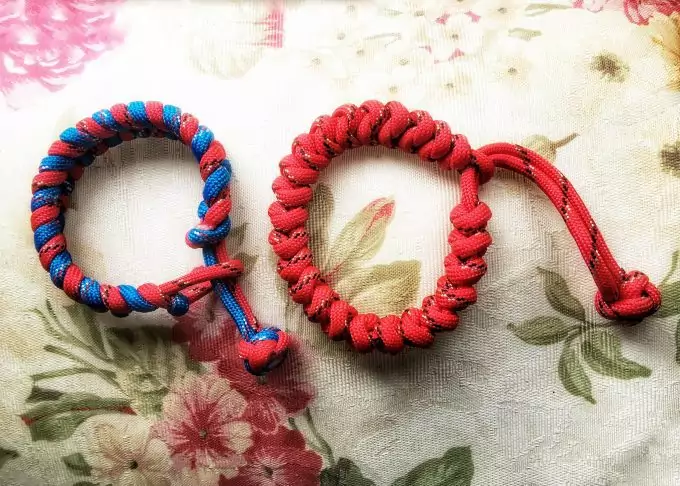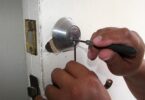When going camping or hiking it is very common to keep all your things in your backpack. But what happens if there are items you need to have access to immediately? Then it becomes difficult to always stop your trekking, remove your backpack and search in it for your item. Use it for a while and return it back in. And then this repeats over and over again. You waste precious time and energy for these repetitive motions instead of keeping ahead and using your item (GPS, compass, etc) immediately, if it’s tied to your belt, placed around your neck, etc.
[the_ad_placement id=”in-text-1-type-r”]That’s why having a paracord lanyard these days gathers a lot of interest and popularity among survivalists and hikers. At first it may seem difficult and complicated to make your own lanyard, but it doesn’t have to be, as long as you follow the instructions.

In this article we’ll guide you through the process of making your own paracord lanyard.
Paracord lanyard necklace instructions
To make a paracord lanyard you will need several items and tools to help you:
- carabineer (alternatively, snap hook)
- paracord 550
- lighter (or some safe source of fire) to seal the ends of the paracord (where you will cut them)
- knife or scissors for cutting the paracord
Step-by-step Instructions:
- Take two paracord lines. Choose them to be of contrasting colors so when you tie them in it will be easy to follow which end is which. For the purpose of these instructions we will use a black and orange paracord.
- Use the lighter and melt each end of the two paracords. While they are still hot and melted stick them together (so you end up having one longer cord). Hold them until the paracord material has cooled and you can no longer separate the two cords.
- Take the snap hook or carabineer and, with the joined end of the cord, fold it into two, place it through the carabineer/snap hook and thread it through itself.
- Next, separate visually the two (black and orange) cords. Let’s start with the black. Make a loop of it, to prepare it to thread through it the orange cord. Then put the orange cord through the loop. Don’t tighten it yet. Let it stay loose.
- As the orange cord is through the black loop, take the orange cord and thread it one more time through the black cord, making a mirror loop. Then thread the black cord through the new orange loop. Remember the steps and order of the cords (which was above which). The process is like placing shoelaces through the shoe’s holes – there is freedom for you to choose which side should be above or below the other, but you need to remember this order, so the knots are always consistent and harmonic.
- Tighten the knot slightly, to see if it’s alright. Otherwise, you still need to pull one more orange cord through the black loop, and as you do so, the orange cord will create another loop, keep a black cord in it. As you tighten you will have two orange cords in one black loop. If you flip over the paracord at that time you will see that the back should have two black cords tied in an orange loop (the colors change according to the side, but the basic tying is the same on both sides).
- Slightly tighten the new knot. Again, you have to pull a new cord through. Take the black cord and pull it through the last orange loop, and thread through the black loop an orange cord. Now you can flip over the paracord knot like you did before and do the same thing – take an orange cord and thread through the last black loop, and keep a black cord through the new orange loop. Tighten slightly, and flip over again, and tie the black cord through the orange loop, and so on. You need to repeat this process until you have reached your desired length of the paracord.
- Use the lighter again to seal the sticking end to the whole braid. The remaining cord (either the black or the orange part) will be left for your neck. It should be wide enough for you to place it on your neck. Before you start making your paracord lanyard you can mark the cords where you need to stop making knots. This is to make sure you haven’t made the neck area too tight.
Make a paracord lanyard using the cobra knot
Here is another version of the above method, slightly altered. You will need two paracords 550 (of different colors) – 2 feet in length; a lighter, knife or scissors in case you need to cut an edge, a key ring/clip and a release.
Tie each paracord to the key ring in so you have 1/3 of the length with which to make the actual paracord knot (also called Diamond knot). When you do the first tie it should be the same as when you do the first tying of your shoes, nothing fancy – just a regular tie.

Next make a loop similar to the above, but this time it should start and look like the letter C. Do the same with the other cord and make the mirror image of C. Thread each cord through the opposite hole and tighten the knot.
Repeat this step but begin with the opposite end, and make a mirror image of C. Repeat this with the other cord and make the C image. Thread the cords through and tighten. Keep doing this process and remember to always start each knot with the same cord, which you used to start the first paracord knot. If you chose the orange cord, always make each new knot with the orange. It will change from left to right every time you complete the knot, but don’t worry. That’s the idea.
As you’ve reached the ends of the paracord, you can either cut them or if they weren’t long since the beginning, it’s time to use the lighter and melt the edges so the knot stays tight (and will not under any circumstances untie or loosen).
As the knot part is ready, take the other two edges and use the release to hold them together. You can again use the lighter to melt the edges to each other to keep it even stronger. Add the release and you’re done. Always measure the paracord around your neck before you finish with the melting.
Here is a YouTube video which shows the exact process of the above steps:
In this video you can see a version with a basic paracord tied in the beginning and a second (joined) paracord, used for the knot.
If you’re interested in learning more about the other knots you can make with paracord, take a look at our step-by-step tutorial on various paracord knots.
How to make a paracord lanyard belt
Knowing how to tie a diamond and cobra knots is already advancement, but there are yet other methods of making lanyards with multiple purposes. Here is how to make a belt using knots.
Before you start you need to be aware of your waist size. On average, if your waist is about 32″, then you’ll need about 50 feet for the 550 paracord. Prepare some scissors or knife, lighter and a belt buckle.

Melt the edges slightly, so they can’t unravel. Take the belt buckle and thread through it one of the cord edges. Loop the cord 4 times around the belt’s opening and arrange the cords so they are parallel to each other (not overlapping). Make a knot at the end of the cord, so it won’t move and gets stuck to the belt buckle. The rest of the cords length is what you’ll be working with.
Now take the loose cord with which you’ll work, make a finger-length loop with it and tie straight through the 4 cords on the belt buckle. It will look like a tiny noose. Make sure that the continuing end of the cord (on the noose) is right on top of the other end. Thus, when you tie the knots, you’ll always pull freely the loose untied end of the cord.
Next, spread a bit 2 of the 4 cords attached to the buckle – those two right next to the new noose you just made. You can now see the cord below the 4 loops. Take a pencil or a skewer and pull the free cord from the noose (the one which we determined to be on top of the other, as explained in the previous paragraph). Pull the cord so it looks like a finger and has a similar length to the first noose. Now you have a second noose.
Repeat this process with the remaining 3 belt buckle loops. In the end you should have something looking like a 4-fingered hand.
[the_ad_placement id=”in-text-2-type-r”]With this setting, you can put your index finger through the 4 new loops (finger-shaped). Thus you arrange them better. Now you basically have to repeat the beginning – thread a noose through these 4 loops and tighten slightly so it isn’t loose and making hard for you to continue.

When you threaded the new noose, to tighten you can start from left to right – pull the last but one ‘finger’ loop from the back – it will tighten nicely the first (left to right) ‘finger’ loop. If you pull the third this will tighten the second and so on. When you pull the last ‘finger’ loop it will look like a mirror image to your second noose. Slightly pull more cord for the second noose to make it larger. To fix this you only need to pull the bottom part of the second noose (remember, the above part is the one which you pull from when you tie the belt, and it’s the rest of your paracord).
As you pull the bottom part of the noose, it will tighten that last ‘finger’ loop and you’re ready and set to repeat the whole thing – you need new ‘finger’ loops. Tighten then again and make a new noose, and so on. You have to be patient with this, as it takes some time.
When you came to the end of the belt, you will end up with the final 4 ‘finger’ loops. Thread them through the other part of the belt bucket. You should still have the free paracord end untied. It should not go through the belt bucket. Take it, and make another noose. Thread that noose through the 4 ‘finger’ loops, pull the belt you tied to tighten the new noose to the belt bucket.
Thread through this last noose the free paracord end and tighten more. Now you’re ready to cut the free cord 2-3 inches from where it’s tightened to the last noose. Use the lighter to melt and burn the cut edge. You can cut it even closer to the belt itself if you think it won’t untie. Another option is just to make a tiny knot at the end, so it’s more secure. You’re done.
Here is a detailed video on how to proceed with the tying.
How to make a paracord lanyard bracelet
These instructions use the ‘single genoese’ method of tying the knots. It’s not difficult and creates a nice pattern.
You will need the same tools as described in the above tutorials – paracords (of different colors), bracelet buckle, lighter (or matches), optionally knife or scissors. Take the two paracords, melt the edges and join them together (just like we described before). Thread them through one end of the bracelet buckle and tighten it to itself.
Next, thread through the other buckle end the loose edges of the paracords. Correct the length of the paracord between the two buckle ends (depending on the thickness of your wrist). You’re ready to knead the bracelet.

Separate the two ends (one will be black and the other orange). You need to position the bracelet so that the two edges coming through the adjustable buckle face you (and are not face-down on the table).
Take the orange end (let’s say, that the right cord) and start by making a loop that goes over the bracelet and behind it. Then it goes right through itself. Pull it over and tighten this first knot. Do the same knot with the black cord. Keep repeating this process with the remainder of the cords.
When you come to the end of the bracelet you have to complete the braid with the Diamond knot, explained in the first tutorial – make two loops and thread the opposite end through the opposite loop to tighten the entire lanyard. As you did this, make another noose with the black cord – the noose to be to your right. Take the orange cord and place it over the black on the left side. Then move it behind and then right through the black noose. Tighten one more time.
For more detailed instructions you can watch this video on youtube.
Now cut each cord and melt the edges to prevent it from unraveling.
If you liked this project, you may also like making regular paracord bracelets, which are extremely useful in a survival situation. We have a great tutorial on how to make a bracelet in this article, here.
How to make paracord lanyard bracelet without buckle
Another way of making a bracelet can be done without a bracelet buckle and can be done entirely just using the two interweaving paracords. One end of the braided bracelet will have a noose/loop and the other will be a double king knot to pull through the loop and attach as a bracelet. You need two cords of different colors, lighter or matches and a knife or scissors.

Begin by making a small loop right in the middle of the black cord. Cross its two cord ends and pull though the loop the orange cord. The black loop will be the one through which in the end you’ll pull the final knot and have the bracelet done.
Tighten the orange cord and have its both end next to each other. The black ends should be to the far left and far right. Take the left orange end and place it over the other orange end. Place it behind and then back to its original place, making a full circle around itself.
Then take the right black end, place it behind and then right between the two orange ends. Tighten. Again, take the left orange end, rotate it fully from behind and back its starting place. Repeat the same process for the left black end – full rotating and back to the original place. Keep weaving until you have almost reached the end.
[the_ad_placement id=”in-text-3-type-r”]Now take the right orange and left black cords. Pull them opposite to each other (one hand should hold the two orange cords, and the other – the two black cords). Rotate and pull one orange and one black to the opposite ends so you have mixed cords at each hand. Rotate two more times the same way.
Finally you must tie the double knots. Turn the end towards you so you see the interlaced cords. Make two loose loops with the white ends. Thread one black end through one of the orange loops, tightening the other black end below it. Tighten. This is the first knot. Then make two parallel loops with one orange and one black end. Place their ends slightly behind the bracelet.
Take the other loose orange cord, over the black loop and thread it right through the orange loop. The black loose end should go above the orange loop and through the black loop. Now tighten the entire knot. You’re ready to cut the edges and melt them with the lighter.
Here is an instructional video on Youtube explaining the above technique.
There are many variations for the above techniques and many easy or more complicated knots and braids exist. Once getting into this you can also experiment, learn new knots and new ways of weaving. You can then create your own custom pouches, handles, bracelets, necklaces, etc.






I amazed myself at the middle of doing the necklace correctly and afterward I needed to focus hard to keep the pattern going. I’m anticipating making some more.
This is a good skill to learn, keep it up.
One of nieces gave me a paracord necklace and what I really remember was that the braiding was complex enough that there was, I think 40 feet of it. We were hiking up a mountain for a tree planting activity when my decade-old backpack decided to come off so I used the paracord to weave the gap. It was truly convenient because I had my things secured in a jiffy. Needless to say, I asked my niece to teach me to braid a paracord project after that.
Yes indeed, Paracord is highly resourceful, it is strong, durable, lightweight, and water & mildew resistant, and it’s also easy to learn how to use it.
My most used paracord lanyard aside from my key chain lanyard was the paracord camera wrist strap I made a year ago. To make sure you don’t waste the time you spent on this project, use good quality carabiners, keyrings, or snaps so your paracord lanyard will last longer and to avoid losing valuables attached to the paracord. Avoid those cheap plastic snaps that loosen or break after a few months.
Paracord is a highly versatile multi-filament cord with nearly infinite uses, applications, and benefits. It is a must have for any survival as well as emergency preparedness kit.
What could you say is the advantage of making a paracord lanyard instead of just stuffing the paracord into your camping or packing bag? Because I think it will cost you time if you make it into a paracord lanyard and unravel it during emergencies.
It is certainly easier to pack the Paracord in your backpack. However, a lanyard is more convenient because you can use it to hang out your keys, knife, or flashlight.
I am currently working on this. I am doing one for my keys, another for my knife and I would make another one with a compass and flint attached. I am having a lot of fun exploring the different types of lanyard designs you can make.
Paracord is such a strong and versatile material to have especially when going outdoors (hiking, camping). The applications of this material are endless. It is also water and mildew resistant so it is a good investment and is sure to last a long time for your camping needs.
A Paracord lanyard is one of the most resourceful gears for a backpacker. Apart from ensuring that all your small items are readily available for use while on the trail, it stuffs Paracord that can come in handy in a survival situation. So, it’s wise to learn how to make one.
You will never really be a complete backpacker if you have not embraced the importance of Paracord. One of the best ways that you can always ensure that you carry Paracord with you when in the woods is a Paracord lanyard. The article provides you with basic DIY steps for making a resourceful lanyard.
It all started way back my elementary years. One of the survival skills that a girl scout should have is the skill in tying knots. Never did I think that it would be this useful in different aspects of my life. Aside from making some for my keys, I began making simple presents like necklace, bracelets, and key chains for my friends. Until such time, orders are coming and it turned out to be a small business. Thanks to this informative essay; I have got new styles to produce.
Well, we are glad our article has been a great help for you. Paracord projects are among the most important survival skills. And as per your experience, you transformed such skills into a business.